Site POINT
ALASKA


The Last AADCP
of the
Last Operational U.S. Nike-Hercules Missile Battalion
Last updated 09 July, 2009


Last updated 09 July, 2009
This is about preserving a tiny bit of mostly forgotten trivia which was a part of the history of the Cold War. This history is rapidly disappearing as the inevitable march of time progresses, so for the benefit of those that may come after us, I thought I would put together this document in an attempt to preserve some of what I witnessed.
Another aspect of that arms race was the need for the United States to develop advanced air defense capability to neutralize any military attack by Soviet Bombers. This resulted in the Nike series of anti-aircraft missiles, beginning with the Nike Ajax, which was soon replaced by the much more capable Nike Hercules. Others followed (Nike Spartan, Nike Zeus and Nike Sprint) with an eye toward a more effective defense against Soviet ballistic missiles but these were never fully deployed due to the Anti-Ballistic Missile treaty, so it appears that the Nike Hercules missile was the most capable and effective area defense missile ever fully deployed on U.S. soil.
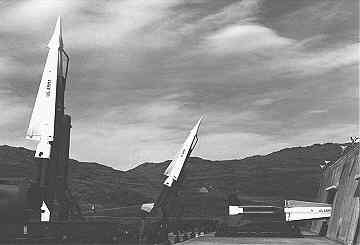
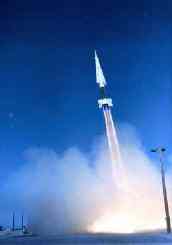
By the way, the Hercules is no light weight contender for air supremacy. The missile with its booster is 41 feet long and weighs in excess of 10,000 pounds. Within seconds of launch it is supersonic, reaching speeds appreaching 3,000 miles per hour and can engage airborne targets at altitudes over 100,000 feet and ranges exceeding 75 miles. It can carry a large high explosive conventional warhead or nuclear devices with selectable yeilds between about 2 and 40 kilotons - sufficient for engaging most conceivable targets. In action a single firing battery could launch and engage a new target approximately every two minutes. Another little-known fact is that it was considered to be the most accurate ground-to-ground artillery piece in the U.S. arsenal as well, though the primary mission of course, was air defense.
The photograph below (courtesy a site Bay alumnus) was selected to give an appreciation for the true size of these beautiful missiles since many photographs give no frame of reference to the viewer. To give appreciation for the energy released at launch, consider that the burn time of the four rockets in the booster section (the black part) is only about three and one half (3.6) seconds.
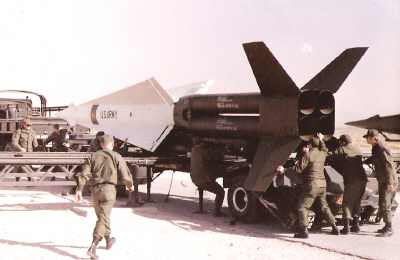
From the late 1950's through the early 1970's, Nike batteries were emplaced at about 145 installations surrounding major cities in the United States. As the longer range and nuclear-capable Hercules slowly replaced the smaller Ajax, many installations became redundant and were subsequently deactivated. As other strategic systems were developed and the political situation changed, the Hercules missile batteries were gradually deactivated as well, with the last of the continental United State's Hercules units under ARADCOM being deactivated in 1974. However, the defensive requirements of NORAD kept two of these units active until July of 1979. One of these last battalions was stationed in Florida at Homestead AFB, and the other one was the 1st battalion, 43rd Air Defense Artillery stationed at the Anchorage/Fort Richardson/Elmendorf AFB complex in Alaska.
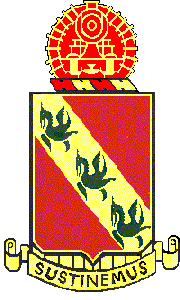
The 1/43's primary mission was to neutralize or eliminate any air-breathing threat to the Anchorage/Elmendorf complex - whether a single aricraft or a massive formation. We stood ready at all times, around the clock, seven days a week to do just that. NORAD's early warning system and the Air Force's interceptors at the remote sites in the bush were the first line of defense, but the last line was a ring of supersonic fire around the area provided by the missilemen of the 1/43.
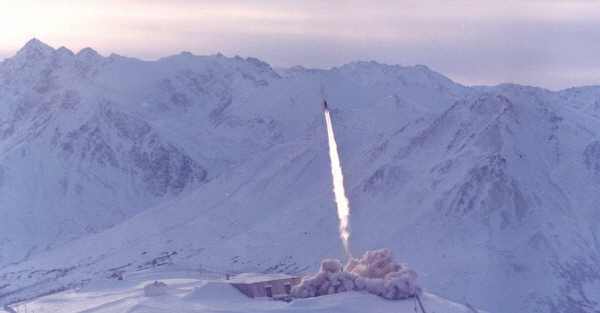
This photograph was provided by an officer of site Point A battery who captured it during a practice firing at B battery in Novenber, 1961.
The battalion was composed of four batteries; HHB (Headquarters and Headquarters Battery) , stationed at Fort Richardson just northeast of Anchorage, adjacent to Elmendorf AFB; C Battery at site Bay across the Knik arm of Cook inlet from Anchorage at Goose Bay; B Battery at site Summit on the top of a mountain just east of Anchorage; and A Battery at site Point which was on the Point Campbell military reservation just southwest of Anchorage International Airport, which in turn is just southwest of Anchorage. The AADCP was a detachment of HHB, assigned to A Battery's location at site Point while I was there.
Site Point A battery was originally set up as a dual firing battery with four launcher sections instead of just the normal two. In addition, the IFC area of this battery included two of the standard main buildings, each with its normal compliment of towers for the various radars. I have always wondered why site Point was set up as a dual battery.
One responder to my request for information replies:
"There were 2 fully operational systems at battery A, and one system each at battery B and C. We updated these all to improved herc sites in early 63." and: "I don't have a clear recollection about A battery layout but here is what I remember. A large main building which housed troops, mess hall, PX, etc and contained one system. Attended great USO shows there and ate good food for a change. There was a second building a short distance away which housed the second battery...I haven't thought of these details since 64. Sounds like they deactivated the second system when you were there. Makes sense. I never understood why there were 2 in the first place."
Among other things, the Improved Hercules system added Anti-Ballistic Missile capability and greater resistance to ECM (Electronic Counter Measures). These capabilities were attained partly by the addition of the TRR (Target Range Radar). The aerial photograph below shows site Point when it was very young, circa 1962. The view is toward the southwest. The dual IFC buildings are in the foreground and the four launcher sections beyond. The southern end of Fire Island can be seen in the background. This is a Signal Corps photograph supplied to me by an officer stationed there in the early 1960's. Most of the following B&W images were supplied to me by the same source.
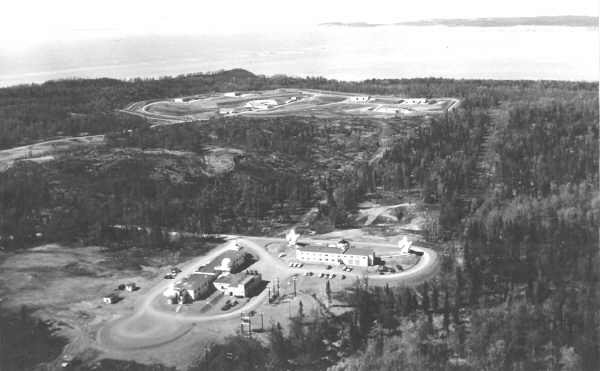
In this enlarged portion (below) of the photo you can see that the tall TTR towers of later years have not yet been added indicating that at this time the systems had not yet been upgraded to Improved Hercules. In this photo the TTR antennas are installed in the lower towers occupied later by the TRR's. Note too that the big ABAR "golf ball" has yet to be built.
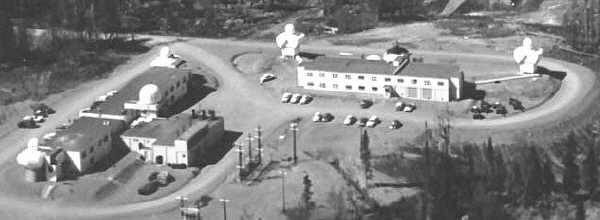
This next photo was taken from the ABAR tower looking west and shows the IFC building of the second fire unit in it's heyday as a fully functional IFC complete with all the Improved Hercules radars. Note the tall TTR tower on the right. This photo was taken sometime after 1963 but before 1970.
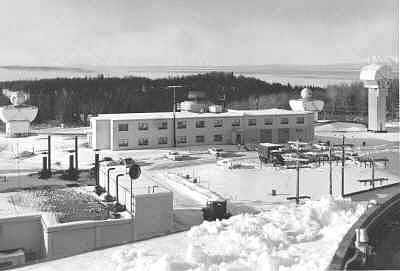
The photo below shows a rare view of a fully operational dual Improved Hercules battery. In fact, this battery was unique in that it is of the Alaskan design (clamshell covers, etc.) and a dual battery as well. There was only ONE Alaskan dual battery. This is A battery circa 1964(?). Note that the radome is not yet covering the ABAR antenna.

By the time of my tenure at the site, A Battery had become a single fire unit occupying one main building and the AADCP occupied the other. Needless to say, the AADCP was not a firing battery and therefore had no need for its own target and missile tracking radars so the building's radar towers were unpopulated. From the condition of the mechanicals inside these towers at the time I was there it was obvious that they had not been used for many years. We got a direct feed from A Battery's large acquisition radar, the ABAR. B and C batterys were each equipped with their own HIPAR (High Powered Acquisition Radar). It was my understanding that our ABAR was one of only two like it in the world at that time, the second being at Homestead AFB in Florida.
We had little information about the history of the site prior to our time there and there was speculation that the second building that the AADCP occupied was at some time in the past the home of a fourth firing battery (D?) and that the AADCP was stationed at the facility just to the west out in Cook inlet on Fire Island, but no one we asked had any real facts about it. At that time, I had a large pair of 11x80 binoculars. With them from the top of the old TTR tower at site Point I could see a number of buildings on the island. One appeared to be similar to the battery buildings we lived in, and there was at least one (and possibly two) radomes visible, but I don't recall ever seeing much if any activity on the island. Once some of us foolishly considered attempting a crossing of the inlet on foot to explore the island. At times of extremely low tide, we figured we could make it most of the way on foot across the mud, then swim the last part. After sampling the mud we quickly wisened up. We never did get around to hiring a boat or airplane, so the place has always been a mystery and held a weird attraction for me. The photograph below shows the Fire Island facility as it appeard in May of 1961. The view is toward the northeast.

The facility on Fire Island did indeed house the original AADCP and had at one time been the Fire Island NORAD Control Center. The Fire Island NCC, along with the Murphy Dome NCC near Fairbanks, became active in September of 1951. The King Salmon NCC became active two months later. Fire Island was mostly staffed by the 626th AC&W Squadron and in late June of 1968 there were 147 Air Force and 16 civilian personnel manning the station. In addition there were 21 Army personnel manning the AADCP consisting of 4 officers and 17 enlisted men.
In April of 1969, in the face of budget cuts (largely due to the drain on resources by the Vietnam war and an evolving response to a changing Soviet threat) there was a coordination meeting regarding the future of Fire Island where representatives from the Army indicated:
"...they can vacate Fire Island as programmed, however, there will be problems of over-crowding at site point (their selected site) ... The temporary crowding conditions can be tolerated..."
In the last half of 1969 the Fire Island facility was closed down and its function absorbed by the King Salmon NORAD control center. One responder described the deactivation of the Fire Island NCC like this:
"I watched everything from bunk beds to desks and filing cabinets bull dozed into holes and covered with dirt, the wood buildings also. I always remember what a waste I thought it was!"
It was at that time (or early 1970) that the dual firing battery at site point was reduced to the single fire unit. That year and the following year brought the closing of the Nike-Hercules sites of the 2/562 Artillery in the Fairbanks area as well. The photograph below of the second IFC building at site Point was taken sometime between 1970 and 1972. One respondee indicated that in this photo the building looks the same way it did when he left the site in January of 1971. As you can see the towers are now empty and the IFF and radio antennas of the AADCP are not yet present.
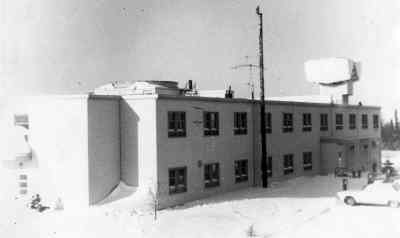
One responder (who supplied the photo below) mentions that the AADCP was temporarily set up at Ft. Richardson (in 1969 or 70) until it was moved into its final location at site Point - probably 1971 but definitely prior to November of that year. He says:
"At one time or another it was even located in the basement of the 4-43rd company headquarters. The Group headquarters was on the 2nd floor of the same building located behind the NCO club on Fort Rich."
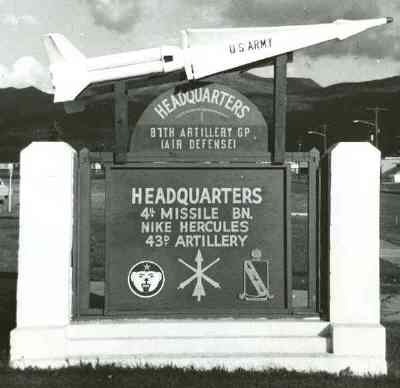
The Anchorage area's 4/43 Artillery was redesignated as the 1/43 ADA in 1971.
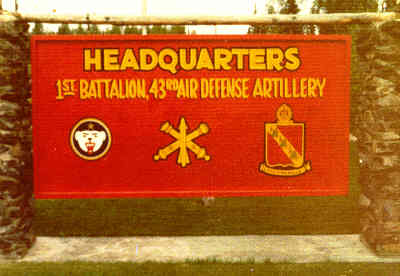
For more information about the history of remote radar surveillance sites in Alaska and elsewhere I invite you to visit the Online Air Defense Radar Museum at http://www.radomes.org/museum/
(To learn more about the history of Fire Island, see photographs, and read interesting anecdotes from people that lived there, CLICK HERE. To view many recent photographs taken during an Anchorage resident's camping trips on the island in 2004 and 2005 you can CLICK HERE. I found both of these websites fascinating.)
No description of site Point is complete without a description of the events surrounding the great Good Friday earthquake of March, 1964. This devastating natural disaster resulted in trememdous destruction and loss of life in the Anchorage area and site Point was by no means unscathed. In fact the battery suffered extreme damage and a disaster of possibly greater dimension was narrowly avoided. Anyone who has visited Earthquake Park or driven on Minnesota Avenue in Anchorage can see how the landscape was affected.
Even the utility of Fire Island was altered. I recall hearing that the Island had sunk as much as 70 feet during the quake. (The drop off at Minnesota Avenue is at least that much.) After the quake one of the airstrips at Fire Island became perpetually underwater at high tide. During my stay in the late 1970's there was a large stretch of mud but there was always a wide span of water between site Point and the island even at the lowest tides. One responder notes:
"I know that - before the earthquake - at low tide, it was just mud between Campbell Point and Fire Island and a person could walk (maybe) between the two places."
The following is from a series of communications with the man who was the A battery executive officer at the time:
"Ground motion in an earthquake can be multi directional - particularly during the large initial quake. The damaged and torn missile skins provided ample evidence of the many directions taken by the earth during all the initial shaking. And it went on for such a long time. For me, I couldn't stand up. I couldn't sit down. The ground was going up and down, and round and round. In the many aftershocks, the ground motion might ripple in only one direction."
"Many of the aftershocks were gigantic by today's standards even for California..." [as an example] " I was walking around the area one day when I heard a big quake approaching. Not only did I hear the ground rumbling. It sounded like the wind blowing through the trees. Only the wind wasn't blowing. I glanced over at a stand of trees and saw the tree tops moving back and forth rapidly. Like water rippling across a pond, the ground was moving and causing the trees to shake back and forth."
"We had a road grader on site to keep the roads clear and often it would be parked close by the administrative area. During the shake, the grader began to 'dance' from side to side. Eventually, it was dancing so wildly that only the tips of the scraper blade were making contact with the ground. After the shaking stopped, the ground was thoroughly gouged up."
Perhaps even more profound is the following account of the condition of the launcher area:
[After the shaking of the initial quake had stopped] "We went inside the first launcher section of the fire unit on 'hot status' after prying open the blast doors. It was a big mess. No complete missile round was intact on the tracked launchers or handling rails. All the yoke structures had been sheared. The skins were gouged open; fins bent in all directions. Solid propellants cracked and the rocket motor covers were off. Strong stench from the exposed rocket propellant. Arming lanyards were pulled, energizing the on-board battery operated electrical power systems and gyros were spinning. Large components strung across the handling rails and launchers and on the floor, in all directions. Each missile representing upwards of 5 tons of high explosive just waiting for the initial spark to set off the entire lot... [After 40 years] I still have nightmares about what I saw in the first launcher section immediately after the earthquake."
The photograph below shows the two launcher buildings of the section referred to. The building on the left was the first opened after the initial quake. The one on the right is now the Kincaid Park Chalet.
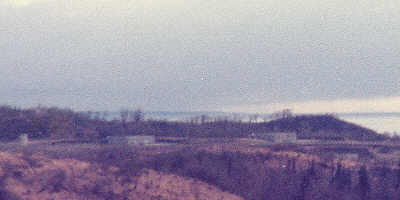
The officer continues: "We loved and respected our ordnance brothers, but there is a story needing to be told. They came out very soon after the big quake (within an hour or so), with their heavy truck rigs and their white uniforms - with spark proof tools and flashlights. The problem we encountered was that none of the missiles looked like what they were expecting to see, based on their warhead manuals and instructions for 'safe isolation and disarming.' Our launcher warrant initially pulled me aside with great concern over the questions the ordnance folks were asking us. We were standing inside the section, with the flashlights and big manual and trying to point out in the mangled mess what the warhead manual was instructing. Indications to my warrant officer, and then to me, were that it was likely the ordnance folks would be more of a hazard than if we just formed up crews on-site and disarmed the missiles ourselves. We heard that a tidal wave was coming up Cook Inlet so that gave us an opportunity to make a hasty retreat to the high ground. Following a brief radio chat with the Battalion CO, it was mutually agreed with ordnance that they would return to Ft Richardson. Ordnance was not unhappy about being asked to leave. They did play a very important role in rebuilding, however....after that 72 hours of round-the-clock work by only our site personnel. ...with assistance now from ordnance, we were able to get back in operation, sort of, at the end of 7 days. We witnessed lots of individual heroism. Some folks ... scared to death, ran away and were gone for days."
The following comments are added by the Missile Warrant Officer on site at the time: "The reason the shear pins on all but 3 or 4 missiles sheared off and the lanyard pulled from between the booster and missile was that the missiles moved forward more than the boosters. This resulted in the lanyards being pulled and the shear pins being sheared. The missiles then dropped onto the forward end of the launch rail penetrating the missile skin. Some of the missiles pulled forward to the point that only an inch or so was left still hanging inside the front of the booster. No missiles actually hit the magazine floor. However, about 4 or 5 were ready to and our first job was to disarm and build support under them to prevent it from happening EOD was not ready or trained for what had to be done that night, but we did not send them away. I don't think we could have if we had wanted to as the problem was their responsibility. What we did do was on the job training for them. Then myself and a missile tech spent the rest of the night disarming the missiles in 3 of the missile sections while EOD disarmed the missiles in the 4th section."
These heroic recovery actions earned A battery a well-deserved Meritorious Unit Commendation the following August.
One of the officers that commanded A-battery in the late 1970's writes:
"When the site storage faciltities were visited following the quake, utter chaos was discovered. Missiles thrown off rails, missiles on and off rails in pieces, etc. So the fix was to modify the system by the addition of the earthquake pin so that the missiles would not be thrown off the handling rails. That was the way modifications were made in Nike. A problem would come up (some quite fatal disasters) and changes would be made. During the ORE one of the steps in the launching area would be to simulate the removal of the pin before the missile would be elevated...I know of at least 2 ORE's for A/1/43 we flunked because a launching crew member failed to simulate the removal of the pin."
Other changes in the water system were implemented due to the local geology in the late 1970's. This officer continues:
"What happened is there had to be a shift of the underground water supply and water wells that supplied the site dried up. Of course it was not overnight. The engineers ... were supposed to check a water reading pressure valve in the area of the generators. If it dropped below a certain level, certain steps were to be completed. Of course the guys did the checks and you could watch the water level drop over a two-week period. What happened is when it got to a certain level, water pumps would supposedly kick in and return the water level to an acceptable reading (ie sufficient water). Of course what actually happened is that when the pumps kicked in, they burned themselves out because there was no water to pump. It wouldn't have made any difference because there was no water to pump but at least the pumps would not have been fried. Water was tanked in for several days and rationed severely. After about a week, the underground springs had readjusted and water was again pumped like before except that the pumps had been provided a cut-off valve. ... nobody had really questioned the need for such a valve before. You learn with experience."
To continue some narrative from the earlier responder:
"At Site Point, we were almost accustomed to the many aftershocks from the big quake. You always slept with your clothes on, even when you weren't on the 'duty' crew. We were prepared at a moment's notice to run outside the building. With so many larger aftershocks, we had learned how to recognize when one was about to hit. You could hear the low pitched rumble through the ground - it reminded me as a child how I was able to hear a train coming in the far distance by the sounds in the rails, even before the train had gotten close enough to hear the whistle."
"Another incident that comes to mind occurred exactly one week after the initial quake - again, at suppertime. By that time, everyone on site was fully cognizant of what (didn't) happen in the launcher area and so were very much on edge about the potential hazards of additional quakes. The ground started shaking violently and the vent hood over the stove made a very loud noise and fell on the cooks. They (and everyone else in the messhall and barracks) ran out into the open. Later, I learned that the noise of the falling range hood created fears that missiles were exploding in the launcher area."
"A funny exchange occurred with a reporter from the Anchorage newspaper when they had a special parade at Ft Richardson honoring A Battery. The reporter asked what was the big deal about A Battery. 'Everybody had troubles with the earthquake. Many people lost their homes and livelihoods, especially in the Turnagain Arms area close by the site.' There was nothing we could say." [The topic of nuclear warheads at the site was not open for discussion.]
Perhaps the biggest thing to celebrate was what didn't happen at site Point.
As an aside, in October of 2005 a work crew was bulldozing a new bike trail through site Point (what is now Kincaid Park) and unearthed, among other things, a damaged and discarded fin from a Nike-Hercules booster. The general consensus is that the fin was misplaced during cleanup operations after the earthquake, buried with the other items, then subsequently discovered 41 years later. CLICK HERE to see photographs of this fin and the other items and a presentation detailing evidence suggesting a 1964 date for the fin's burial.
For a discussion of the geology of the 1/43's operational area and that of the surrounding south central Alaskan mountain ranges, you may CLICK HERE for a document written about that very topic by a soldier in the mid-1960's (probably) timeframe. Be advised this is a 710K pdf file.
To get to site Point from Anchorage one would turn west on Raspberry road off of Jewel Lake road. I don't remember for sure whether you would stay on Raspberry or turn south on Sand Lake and take Strawberry, but at any rate the road was unpaved at that time and we called it Battery Road. Following this road a couple of minutes would lead you past a right turn that would take you to Beer Can Lake as we called it. Some folks called it Battery Lake but I think the real name is Little Campbell Lake, which is about a mile as the crow flies east of site Point. This was a spot that saw a lot of A Battery visitors. There were a couple of guys that saved their pennies and bought snowmobiles and would race them on that lake in the winter.
To continue west on battery road was a fairly winding climb up to the top of site Point with a few plywood signs along the way marked in black letters on a white background informing you that the land on either side of the road was a U.S. Army military reservation. Near the end the road forked. The main buildings were around a corner to the right (north), and continuing straight would take you down range as we called it to the launcher area. There was a well marked sign that said "No Trespassing, Deadly Force is Authorized" or something to that effect.
Along the road that lead between the main buildings and the launch area were a couple of underground concrete reinforced storage bunkers. The one closest to the main buildings was empty and at least during the early part of 1977 was used as a gym where guys could go to play basketball or racquetball. I only went there once but I'm sure it was used a lot as a place to get a noisy workout protected from the weather.
The launcher area was the tip of our flaming sword.
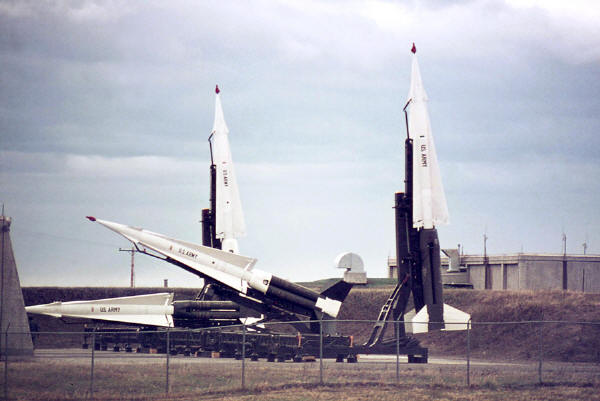
The following series of photographs will hopefully convey the geographic situation of site Point. For many of them I taped prints together to provide a wider field of view in lieu of having a wide angle lens at the time.
This first set of pictures below were taken from the low rise just to the southwest of the main buildings (between the IFC and launcher areas) and spans the view from roughly due west to north. On the left (to the west) can be seen the northern tip of Fire Island and to the NNW the white shape of mount McKinley (Denali) can just be detected. On a clear day it was beautiful. The photo below that continues the pan to the right covering the view from north to east. Here you can see the main buildings of the AADCP (on the left) and A Battery. The large white "golf Ball" is A Battery's main acquisition radar, the ABAR. Beyond and to the east can be seen the mountain on which B Battery is sited. This roll of film was developed in May of 1978.
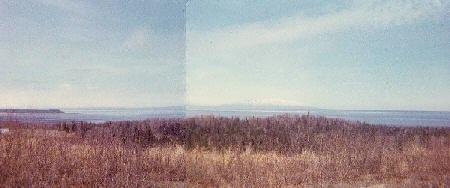

The next picture below was taken in June of 1977 from roughly the same location and gives a slightly better view of the relationships of the buildings. As you can see, the plan of A Battery's building lays in a E-W direction and the AADCP building on the left lays in a N-S direction. Both of the main buildings are identical in general layout, with the AADCP being rotated 90 degrees in a counter-clockwise direction if viewed from above. The A Battery building had some additions for the generators and boilers and other peripheral equipment. The AADCP's empty TTR (Target Tracking Radar) tower is on the far left, just beyond the shorter TRR (Target Range Radar) tower. The other short empty tower (barely seen) at the south end of the AADCP building is for the MTR (Missle Tracking Radar). The red and white IFF antenna mast can be seen, rising from the platform originally meant to support a LOPAR (Low Powered Acquisition Radar) about midway along the length of the AADCP building on its west side.

Here is a sharper winter scene taken from nearly the same spot, but about 6 years earlier (circa 1971). Note that the IFF antenna tower is not yet mounted on top of the AADCP building:
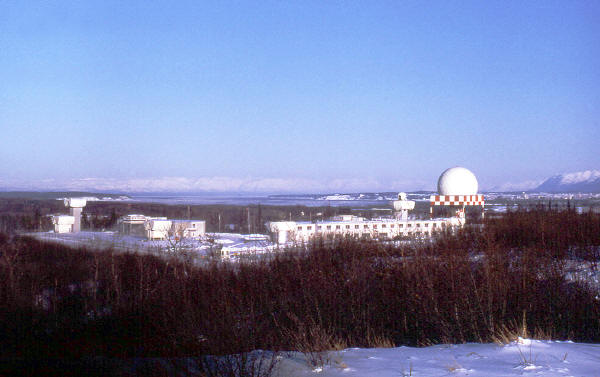
And here is the view looking in approximately the same direction from the air. At extreme lower left you can see part of the launcher area. The ammo storage bunkers are right at the wingtip with the IFC area slightly forward of the wingtip and a bit farther up.The runways of Anchorage International Airport and the Alaska Air National Guard are in the mid distance. Just beyond can be seen the Lake Spenard/Lake Hood seaplane port with the Municipality of Anchorage, Elmendorf AFB, and Fort Richardson stretching into the distance.
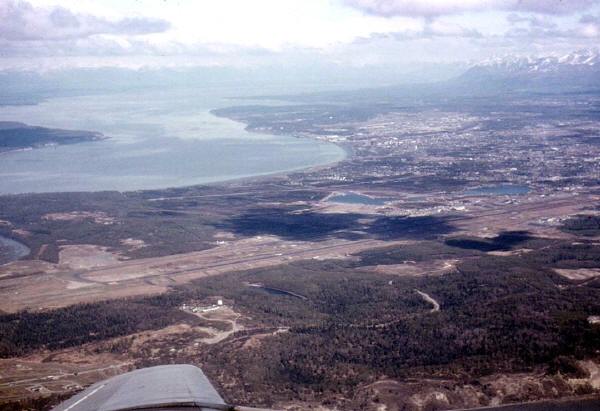
Here is an opposite view of the IFC area taken from an aircraft on final approach to the airport (circa 1972):
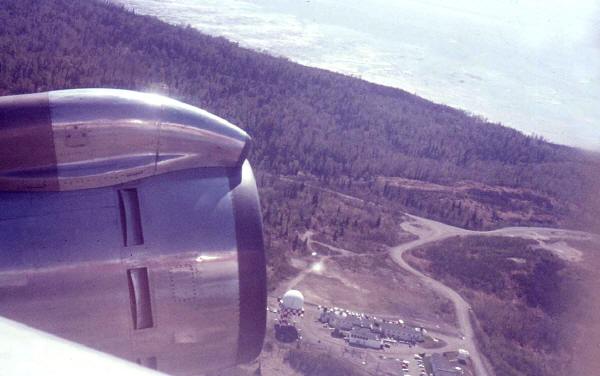
This next series of photographs (below) was taken from the top of the empty TTR tower that is just north of the AADCP building. The first view is toward the south and shows the black roof of the AADCP building in the foreground. On the right is the IFF mast and on the left you can see A Battery's oblong LOPAR antenna and at center the little white ball of the MTR antenna at the west end of the A Battery main building. The big ABAR golf ball is out of the picture to the left. The windows on the upper floor are living quarters. The bright red door in the center of the building is the entrance to the common area. After entering this door, a right turn will take you into the dining facility (mess hall).

The photograph below is toward the southwest showing the launcher areas. Just out of view to the left is the high ground from which the previous series of photographs were taken.
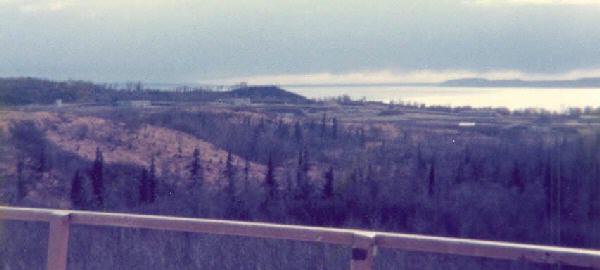
This next picture (below) is toward Anchorage to the northeast. The airport runway is in the near distance and the control tower can just be seen as a black spot on top of a brown post in the center of the photograph.

Since the above series of photographs is incomplete, I have also included the next (incomplete) series of photographs which were taken from the roof of the AADCP. Maybe this will fill in some gaps. The first image is a look back toward the north-northwest at the tall TTR tower from which the previous photos were taken. To its left is the shorter TRR tower.
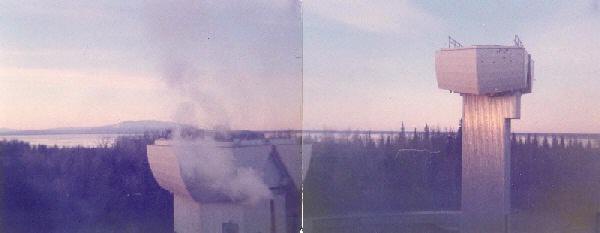
Now we turn our gaze to the east. This next set of images make up a four image pan. (At one time these were a complete set that encompassed the full 360 degrees of view from this point but some are lost.) The first pair of images covers roughly due east on the left to southeast on the right where we see the ABAR dome. Just to the right of this we can see a small part of the tall TTR tower just beyond A Battery's main building.
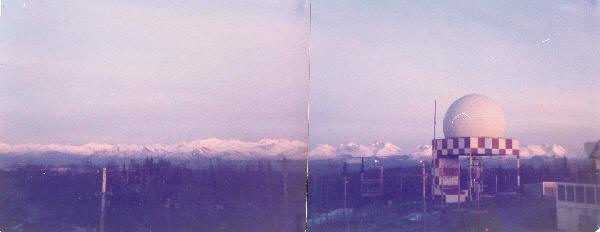
The second pair of images joins the first at the TTR, continuing the pan from that tower to due south where we can see the AADCP's PRC-77 radio antenna in the foreground.
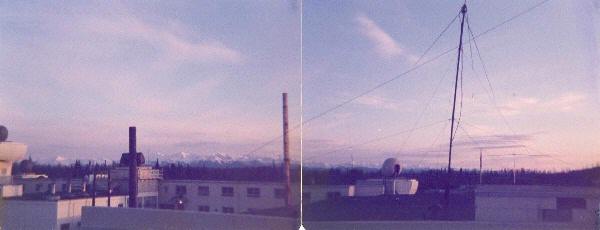
As you can see, the Anchorage International airport runway was just a mile to the northeast of us. There was also an Air National Guard strip to the right of that, where F-4 Phantoms would come and go. Couple these with the Lake Hood/Lake Spenard seaplane port and Elmendorf AFB north of Anchorage and you can see that we truly had a target-rich environment to provide plenty of training for the missile batteries.

During pleasant times of year the area around Point Campbell provided a great hiking environment. There was plenty of wildlife to be seen and some very scenic areas including Earthquake Park and an old aircraft bone yard. From time to time we would hike through the woods to the end of the airport runway to experience the heavy jets landing up close and personal. The view on the left below shows a portion of the fence and maintenance road leading around the boundary of the airport. This view is facing due west toward Fire Island. The woods at the end of the runway are out of view to the right. The picture on the right shows the bottom side of what looks like a Japan Airlines 747 (Guessing by the color of the tail feathers.)
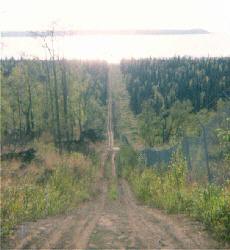
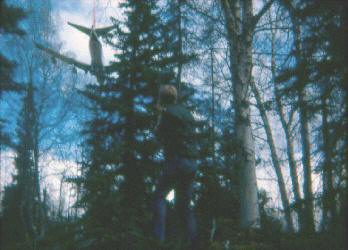
Just south of site Point along the coast was a dump or landfill. It was perched on a steep precipice about 200 feet above the salty mud flats along the shore of the inlet. At the bottom were a number of old cars and washing machines and stuff. We would often go there to shoot since there was a large open area with good backstops and plenty of things to shoot at. The view was breathtaking too. I'm pretty sure that is where this picture was taken:

Most of the AADCP guys spent at least some of their free time at the top of the old TTR tower. It provided a beautiful 360 degree view where we could watch the aircraft coming and going and scan miles of mountains and sea with binoculars. It was a place of peace and serenity just a few short steps from the barracks. The center of the tower was a hollow concrete cylinder with a steel spiral stairway inside it leading up to the top. The door into the stairway was padlocked shut for a long time, but we would climb up the steel scaffolding on the inside of the outer sheeting to get to the top anyway. There were sandbags up there, I suppose for the event that we would ever need a high firing position for site defense, but they made good seats and a comfortable perch. The view below is another taken toward the southwest over the launcher area. This was taken on a clear afternoon at sunset during late fall or early spring, judging by the far southern position of the sunset, and you can see the active volcano of Mount Iliamna rising over 10,000 feet above the inlet in the distance. Actually there are two volcanoes in that direction. Redout is a little bit closer and about 200 feet higher, so what you can see in this frame may be Redout or both of them together. Anyway, on clear days we could sometimes see smoke rising from one of the mountains, and sometimes it would be quiet. In the mid distance is the southern tip of Fire Island.

Another picture taken from the TTR tower on a chilly evening. The view was spectacular from that relaxing little perch.
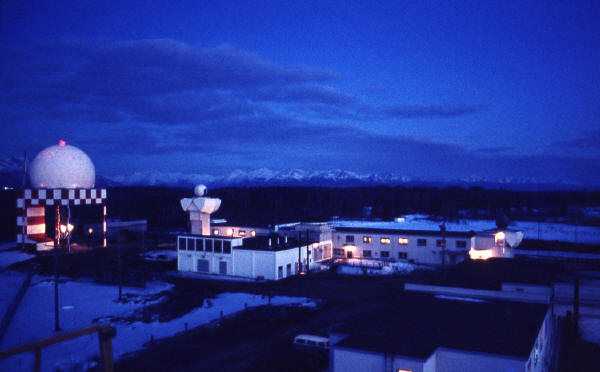
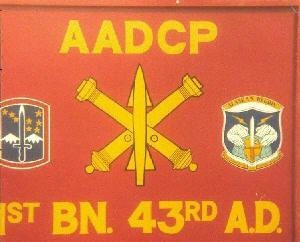
Pictured above is the sign at the front door (east side) of our building toward the north end. There were yellow wooden posts with electrical outlets along both sides of the parking area there so you could power your vehicle's engine block heater. This is a requirement in that region. Almost every car you see up there has a little electric cord hanging out from the front grill or even a coiled extension cord looped on the front bumper.
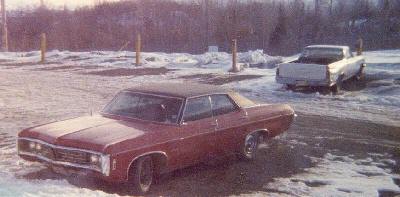
On the left below is a view looking north along the west side of the AADCP taken from near the empty MTR tower. The base of the IFF mast can be seen rising from the LOPAR platform, and the tall TTR and shorter TRR towers are in the background. We had a volleyball net set up just beyond the LOPAR platform. It was not uncommon to find us out there playing in zero degree weather in T-shirts. Once acclimated to an Alaskan winter, a 30 degree day is balmy. In the summer, an 80 degree day could be absolutely suffocating.
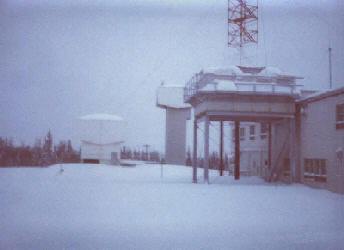
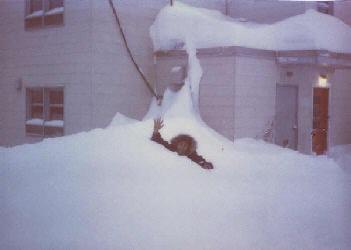
The picture on the right is of the south end of the AADCP building taken from the same spot. Entering the red door will take you past a stairwell to the 2nd floor on the right. Proceeding straight will take you down a hallway with living quarters on each side and will eventually leave you in the "day room" or common area, with the door to the "Blue Room" directly in front of you, at the north end of the building. (No, the fellow in the photograph isn't really in chest-deep snow. This guy was only about five feet tall and is on his knees in this picture. The snow is extra deep there because of the concrete cable troughs that feed into the building from the radar towers.)
Below is one more picture taken from near that spot but facing southeast toward A Battery's MTR, which at the time of this picture had the protective cover off of it for maintenance.
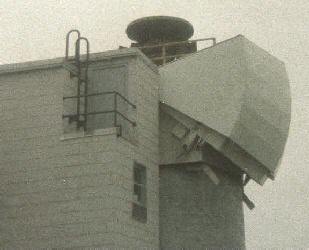
Pretend we have entered the red door above and walked straight past the stairwell on our right and through an inner door into the hallway. The walls are a two-tone pastel green, and the tile on the floor is brick red and shined to a high gloss. Polishing those floors was a nightly duty of the crew on watch, day in and day out, year in and year out. Every night we would get the buffer and the can of floor wax out, light the wax in the can on fire, and dribble some of the melted wax on the floor. We would then go over the floor with the electric buffer, side-to-side, up and down the hall and everywhere else that the tile was, which was everywhere! After that we would take a piece of wool army blanket and place it under the buffer's scrubbing pad and go over it all again, bringing out the gloss and luster. That floor had almost 20 years of wax built up on it and was seasoned like a fine wine.
About the spring of 1979, just prior to getting the word that we were going to be deactivated, someone in charge of the place got the idea that the floor tile needed to be replaced. We couldn't understand why, but sure enough, before we knew it a chipping machine showed up and we proceeded to remove the glorious old stuff from several of the main areas. It was replaced with some tan colored tile that had never seen wax before. It didn't matter how much wax we put on that new tile - it just soaked it up and soaked it up and that floor never shined again. Here is a photo of some of that old tile after laying out in the elements for many years (photo taken 2007):
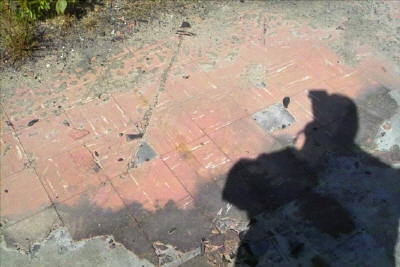
I can't tell you how many times I buffed that stuff in the middle of the night, so long ago...
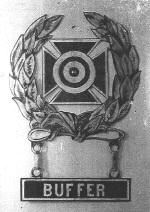
...but I digress... Back to the tour:
If we procede down the hallway to the second door on the right and enter, we find ourselves in my single-room living quarters. Looking straight ahead upon entering we are facing east, looking at the window (left hand photo below). Outside, to the right, we can see the base of the ABAR tower. Inside, just under the window, is my indoor "vegetable garden" sitting on top of my bookcase. It was always a challenge to see what I could grow out of coffee cans in front of that east-facing window over the winter. Here we see some bean vines just beginning to grow in preparation for autumn. Those vines eventually climbed up and over the window. At one time I was able to grow three scrawny turnips from a fruitcake can.Hey! Don't laugh! Let's see what you do for entertainment while holed up in a missile site over a couple of Alaskan winters!
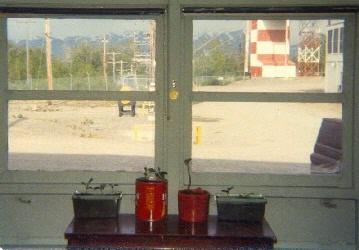
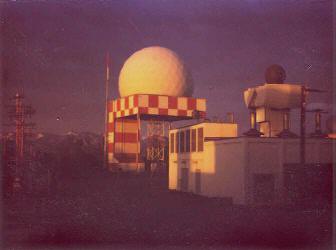
The right hand photo was also taken from that window and shows the "midnight sun" shining on the ABAR dome. Since Anchorage is below the arctic circle, we would never truly get midnight sun, but in late June the sun just dips below the northern horizon for about four hours around midnight. This picture was taken in late June, probably around 11:00 at night. The sun sets about 11:30 and comes up again around 3:00 AM or so, a little ways further east from where it set, melding sunset into sunrise. There is no darkness at night that time of year unless it's cloudy, like in the picture below which shows the sun going down to the right (east) of Mount Susitna which lays to the northwest from site Point. This was probably taken near the same time as the photo of the ABAR above.

Of course, in late December the opposite occurs - the sun comes up about 10:00 AM, slides across the southern horizon, then sets about 2:00 PM, keeping it dark most of the time.
The next picture below was also taken through my window, showing a starkly different time of year. This is just before a morning formation of A Battery, probably in March or april. This roll of film was developed in May of 1978. To the left can be seen the ABAR and TTR, and to the right the oblong antenna of the LOPAR.
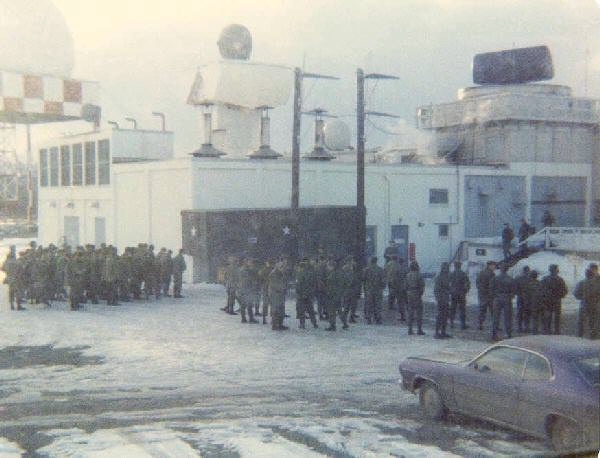
The three chimneys you see on top of the building directly over the green trailer show the location of the generators inside the building. There were three large diesel tugboat engines in there that powered electrical generators for the site in the event that commercial power from Anchorage would fail. Only one was needed to supply the necessary power. The other two were to be used as back-ups, one in reserve and the second trading off with the one working. The photograph below is of one of the generators at C battery.
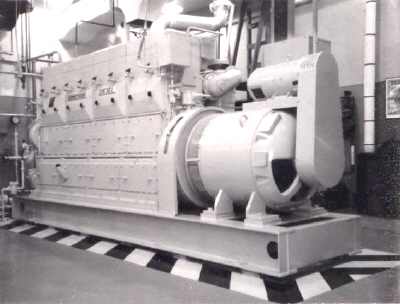
I understand that the diesel fuel tanks were in there as well to keep the fuel warm so it wouldn't gel in the cold of winter. Both buildings were heated with steam pipes. I beleive the boilers for that function were in that large room too. Someone correct me if I'm wrong please. The pipes that heated the AADCP were buried under the roadway between the buildings. I'm pretty sure there was a supplemental boiler or re-heater in our building as well. I do know that sometimes it got downright HOT in those barracks rooms though. The steam heat was effective.
Okay, now let's continue down the hallway. We pass a couple more barracks rooms and a latrine with shower on the left and then the hallway widens out into the day room. If we turn to our right we get the view on the left below. (Photo cropped to remove an unflattering view of one guy relaxing on the floor. There is a window above him to the right. Sorry!) Here we see the television where we were able to watch M*A*S*H and the Seattle Seahawks and come to feed at the ever-popular coffee pot. At that time, live television to Alaska via satellite was brand new. This picture was probably taken at about 6:30 AM on a weekend morning during a shift change. Some of the guys coming off the last 24 hour shift in the Blue Room are passing the baton to some of the next crew.
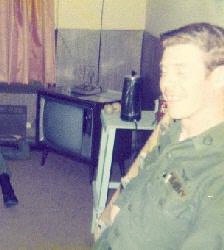
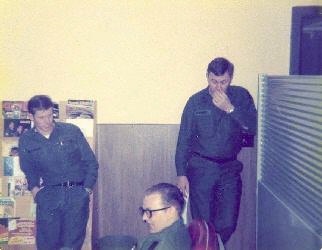
Walking a little further in the same direction as before there is some office space on the left, populated on weekdays by the NCOIC (and others). There we can turn around and see the view on the right above. In the upper right corner of the picture on the right is part of the doorway from the hallway we just walked through. Much is missing in these views. The day room also contained one pinball machine (that if you thumped on the floor just right would give you free games) and a canned beverage machine that supplied cheap beer as well as soda pop for a quarter. The usual brew was Olympia, PrinzBrau, and Old Milwaukee. PrinzBrau (pronounced "prinzbroy") was from a local brewery that I understand went out of business in the early 1980's. Needless to say, we all kept a spare roll of quarters in our rooms.
If we continue on our original course we come to the Blue Room door pictured below. This was the inner door that required you to have a secret clearance, the "need to know", and the combination to the lock to get in. You also had to get past the guys on duty in there. If your name wasn't on a list hanging on the wall inside of that door, you didn't come in - no matter what rank you held.
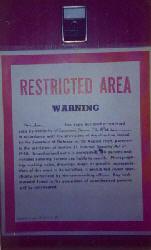
The outer door to the blue room was a heavy red blast door, suspended flush against the wall from a wheeled track that would allow it to roll down and cover the entrance to provide an extra measure of security if needed. While standing here, at the northwest corner of the dayroom facing the Blue Room door, the front door (east side) of the building is on our right hand and to our left is the stairwell that leads to the upper story.
Directly above the Blue Room on the north end was our classroom/assembly area where we held all-hands meetings and some training. If I remember correctly that is where our pool table was. That thing was used almost round the clock, seven days per week. I think we had a Foosball table up there too that got quite a bit of use. Just south of that was a laundry room, large latrine and showers, and more living quarters, and at the end of the hallway was the door to our arts/crafts shop.
It was a fairly well equipped wood shop. It had a drill press, a band saw, and a wood lathe that I can remember - pretty sure it had a table saw too. I don't remember much else about it other than it got very little use. I don't think very many people on the site even knew it was there. I do remember that at one time some of us decided it would be a good idea to freeze salmon that we caught down on the Russian river, then use the band saw in the wood shop to slice them into steaks while they were frozen. After we did that no one went into the shop for several days until we started smelling dead fish in the hallway upstairs - then we remembered sawing up those fish. Oops! Apparently we didn't do a very good job of cleaning up after that operation. Good grief - the salmon sawdust had thawed and begun to rot. It took a bit of effort to get that bright idea cleaned up since the material was scattered all throughout the interior of the band saw and under it. I'm not sure if we ever completely eliminated that odor from the shop. Maybe that's why they dozed the building later. (Not really - I'm sure it wasn't.)
There was an even worse meat-related incident. We had these little 1.6 cubic feet refrigerators in some of the barracks rooms. One time a guy went on leave for two or three weeks and left some ground beef in his 'fridge. Unfortunately, the refrigerator was left unplugged or had failed otherwise. That was a bad one.
At the south end of the wood shop was another door that opened onto the stairwell that would take you back down to the red door we entered at the beginning of this little tour of the AADCP building.
The blue room is where the actual tactical operations of the AADCP took place. I am certain that most of the Hercules stuff has been declassified by now, but I am equally certain that the NORAD stuff that went on in the Blue Room is still quite sensitive, so I won't go into that. Besides, when we left there we signed a paper that said we forgot everything, and to tell the truth, I have forgotten darn near everything anyway, signed paper or not. Until I sat down and started writing this stuff and looking at these old photographs, I couldn't even remember much about the floor plan of the barracks! And of course, I have no photographs of the blue room. Cameras were strictly forbidden in there, but I can give a mental picture of the general layout if you care to read on.
Upon entering the forbidden doorway, we look straight ahead see some double doors at the bottom of a couple of steps that lead into the Blue Room itself. On the left hand is a small bunk room where crewmen could take turns getting short catnaps through the long night shifts. This little bunk room had a barred window that would open to the outside of the building. On the right hand is a doorway that leads into the "commander's dais" (pronounced "di - us"),
The commander's dais was carpeted in blue and was equipped with a long desk with some communications gear and chairs which faced a large curtained window that looked out over the Blue Room proper. At the back of the commander's diais was a large map of Alaska. This was where the brass would hang out during exercises - which was good since it kept them out of our way and let us do our job. It was also a great place to get away from a lot of the equipment noise of the Blue Room itself to study or read. Shoot - that's where I learned trigonometry in my spare time! The large window had a small door in it that could opened to allow enough of the noise through to keep tabs on what was going on in the Blue Room itself.
Immediately on the other side of the large window and down a couple of feet could be seen the three consoles for the AN/TSQ-51 "Missile Mentor" system with their rows of lighted buttons and their large round orange screens sweeping out the radar picture and other information, where we operators would sit and do the hands-on part of entering targets into the system, identifying friend or foe and assigning the targets to the firing batteries. I understand that the -51 system was what replaced the old -38 and "Birdie" systems, and was the predecessor of the AN/TSQ-73.
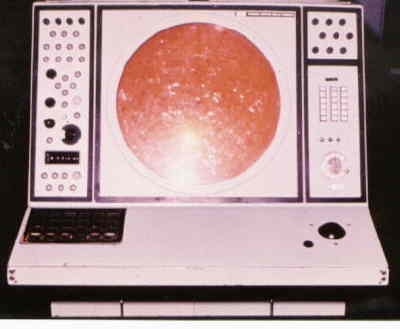
While in the thick of an intense exercise (thank goodness we never had to actually shoot anything down) our upper bodies would sweat while our feet froze from the cooling system exhaust of the consoles. Those consoles had the original computer "mouse". A large black trackball under your right hand that you would use to roll out the cursor over the display with your palm, and a button under your right thumb to "click" with.
While manning one of the positions on those consoles, at times you would be listening to one person in the left earphone, while at the same time listening to someone else in the right. There might be a voice coming over a speaker behind you too, while the tactical commander standing behind you was saying something else. On top of that you may be talking to one of the batterys (or someone else) over one of two microphones in your face, and coordinating with guys at the consoles on either side of you too. Multitasking abilities were a requirement - though it rarely (once or twice) got that intense. If you had a good crew (we did) we could operate seamlessly with a rhythm, intuitively knowing what the other guys were doing or were going to say, for the most part.
Beyond the consoles (from the commander's perspective) and down a couple more steps to the lowest part of the floor was what we called "The Dais". This was a long table with cubbyholes for forms, books, and phones and such where the battery status and most of the communications tasks were performed. There was an old mechanical typewriter there where we recorded everything that happened on a log sheet, round the clock, seven days per week.
Just beyond the dais and up on a tall black riser behind a retractable red curtain was a very large clear plexiglass map with edge lighting that made the markings on it glow bright. The wall behind it was black so there would be no distraction to the viewer by the activity that went on behind it, where there were hookups for headsets and a few chairs for the plotters. This was where the manual plotting, tracking, and status of aircraft was done. This activity went on in parallel with the electronic system. Not only did it provide an immediate backup in the event of some kind of electronic system failure, but it gave the brass some pretty visuals to watch - or I mean, it provided the command staff an immediately readable assessment of the threat situation.
The plotter's job was to listen to aircraft positional and status updates from a number of sources and transcribe these into legible symbology onto the map with colored grease pencils. We used cheesecloth rags to erase old updates with. Since you were standing on the backside of the map, everything had to be written backwards as in a mirror image so that it would come out looking right when viewed from the front. Fast, legible, and accurate were the keys to that duty. No dyslexia allowed, although it could cause dyslexia! Sometimes after a long exercise in that position you would find yourself writing backwards on things by accident or forgetting which direction certain characters normally faced. I specifically remember having to re-teach myself which direction the number "5" is supposed to face once. Weird, huh?
Other items in the Blue Room included displays indicating defense readiness state, readiness condition and equipment status of the batterys and scheduled maintenance, communications gear, and the document safe. 'Nuff said about that. Throughout the Blue Room and its adjoining rooms there were steel diamond plate panels that covered concrete cable troughs in the floor. To this day I can hear the sound your boots made when walking across those plates. The cables ran everywhere under there and tied the various IFF, radar, computer, and console equipment together.
If you turn left at the bottom of the stairs instead of going through the double doors into the blue room, you find yourself in a sort of multi-purpose or storage room where some ECCM (electronic counter-counter measure) equipment was, as well as our protective masks and other stuff.
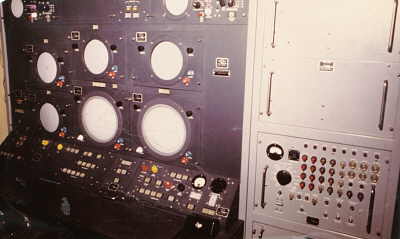
Directly to your left was a small room, adjacent to the little bunk room, that we called "The Ready Room". This is where the real coffee pot was. It was an avocado green, severely stained, aluminum electric urn that held at least two gallons and was never empty. To the best of my memory it was continually running from the first day I saw it in January 1977 to the last time I saw it in the summer of 1979. Who knows how long it had been there before that? The coffee that came out of that thing actually had a green tinge to it if you put it in a white cup, and it would prop your eyes open just as good as you would ever need it to.
The ready room also contained a couple of wall lockers with assorted stores of paper forms, office supplies (lots of colored grease pencils and coffee making materials) and a table with chairs where in the wee hours of the night you could usually find a couple of guys playing cards or other table games. "Risk" was a popular game for a while, as was Pinochle and Spades, and from time to time even a Chess tournament would break out.
Beyond what I called "the multi-purpose room" was a long equipment bay that lead to the van that contained the computer - an ancient relic (by today's standards) that read its program from a paper or Mylar tape. I would imagine that today the computing power of that machine could easily be contained in a space much smaller than a pin head. Things change. There were no CD's, DVD's, or GameBoys back then. Cassette audio tapes were the newest technology and most folks still used 8-track tapes and vinyl disks for their audio pleasure.
On the weekdays there were a number of "day people" that would come in to do their 8-5 jobs. This included the NCOIC that took care of personnel and facility issues and an officer or two. The crews usually filled their time with training or maintaining. For example, I remember that on Tuesday mornings there was a big Japan Airlines 747 that would fly into town, and it would be tracked, locked on, and have numerous simulated missiles fired at it the whole way in.
During any day of the week at any time there was usually some similar activity going on. Sometimes this included the firing batterys, but I think most of what we did was in-house. We also filled time by training the new guys or by doing some of the normal training you would find in any group of soldiers, but to be honest, a lot of the time we were just plain bored.
After the 8-5'ers left, the crews would stand down a bit and crew members would take turns manning the Blue Room. There would always be one or two in the Blue Room itself, standing by for messages from the early warning facilities or others on the NORAD tac loop, or from the batterys, or conducting commo checks and equipment integrations with the batterys. There would be a couple more guys in the ready room shooting the breeze or playing cards while keeping an ear on the activity in the Blue Room, while a couple others went over to the mess hall for some chow or watched TV or something. Later in the night there just wasn't much to do so there would usually be a couple of guys taking a cat nap in the little bunk room. We would take turns doing that so that there was always someone in a refreshed condition at the ready. We rigged it so that on most occasions no one spent more than two hours in there without a break, but sometimes that was a lonnnggg booorrrinnnggg stretch during the wee hours around 1:00 to 4:00 AM. You might get a two hour break before taking another two hour shift. Sometimes more, sometimes less. Sometimes you would pull four or six hours, and sometimes go the distance until relieved by the next crew at 7:00 AM, and sometimes you would only have to pull a single two hour shift in the entire night. There were other duties that could keep you busy when you weren't in the Blue Room - like buffing the building's floors, for instance, or painting or cutting weeds around the building. On weekends we maintained the same fairly relaxed mode of operations.
One of the mental images that remains in my mind pictures the place at 2:00 AM on a snowy winter night. One of the guys in the Blue Room is standing at the dais with a green wool army blanket draped over his shoulders (it was cold in there!) and a headset on doing a commo check with the batterys, while the crew cheif is dozing on the top bunk in the little bunk room, using his field jacket as a blanket. Another guy might be in the ready room writing a letter, and maybe someone else was in the commander's dais sitting in the big leather chair reading a book and dozing off to the sound of the static coming over a box. I was in all of those positions many times. I can still snooze comfortably with boots on using a field jacket as a blanket.
Every now and then, maybe once every couple of months, in the wee hours of the night some clown would make a funny over the NORAD tac loop. It might be a snoring sound, or a raspberry, or some other short quip. I remember one night someone came across with "Spock to the bridge!". There was no way to tell who or where it came from. It could have been from any one of many large and small facilities scattered all over the continent. It would perk people up though and lighten things a little. I don't remember ever hearing stuff like that come over the battalion loop though.
A very positive aspect of those long boring nights was that we would spend countless hours reading and memorizing some of the pertinent documents in the safe relating to rules of engagement and such. This made us into extremely valuable assets for the tactical commanders that had little repetitive exposure to this important stuff, so when the time came for action during exercises, things would run very smoothly for the tactical officer that, because of the very nature of his normal day-to-day job, had spent very little time in the Blue Room. I think this contributed greatly to the reasons for the rapid promotions that were common for the enlisted men that worked there.
I think another factor which contributed to rapid promotions for a lot of the AADCP guys was the fact that there were so darn few of us that were trained and capable. This situation was not improved by the untimely occurance of a great tragedy. One day while I was manning the dais in the Blue Room I picked up a phone call from the King Salmon control center. The fellow on the other end of the line asked me if a certain group of persons had left yet for their trip to King Salmon to tour the facility. I told him that to the best of my knowledge they had left several hours ago... Uh oh...
At that time our current battalion commander was preparing to turn over the command to his replacement. In fact a very large portion of the battalion staff was changing hands. From what I and others can remember, both the incoming and outgoing battalion comanders, the battalion sergeant major, and a couple of personnel from the S3 and the AADCP were on that flight to tour King Salmon. It was a very sad day for the battalion - and a lot of folks and families at Fort Richardson. There was a massive search effort to no avail. We speculated many wild things for a long time after that - that they had crunched into mount Iliamna, or perhaps had been shot down by Russians and squirreled away in a submarine. Until recently, to the best of my knowledge that aircraft was never found, One of the battalion's officers of the time writes:
"I think a total of eight people were lost, since there might have been an enlisted crew chief assigned to the aircraft (not sure about that). I know at least two pilots and five 1/43 personnel were lost. What happened (a recurring problem from air controllers stand point) was that the plane was vectored towards the mountain [Mount Iliamna] but the altitude seemed to be a problem (wasn't the mountain like 11k feet elevation and initial flight control plan was for 7-8k elevation). The army plane in early 1977 was not the only plane that had been flown into that blasted large hill."
Another soldier from that time has responded with: "I remember very well the day we found out our old Battalion Commander or old Battalion Sergeant Major along with our new incoming Battalion Commander and incoming Battalion Sergeant Major flew out to King Salmon and hit Mt. Illiamna. At the time we at Alpha were scheduled to go to Ft. Bliss for Annual Service Practice. It was local practice that the Battalion Commander and Sergeant Major would see us off at the airport to wish us good firing. The night we left for ASP was two days after they went down. We were seen off at the airport by the wives of those brave and never forgotten soldiers. I can tell you there wasn't a dry eye in that group that night at Anchorage Int'l Airport. We went on and fired the highest score a line unit has ever achieved at McGreggeor range in the history of Annual Service Practice. 99.9 score. It was done in their honor, but our hearts weren't in it."
That left the battalion in a world of hurt. At that time quite a few of the old guard at the AADCP were rotating out or their enlistments were ending too. The 1st lieutenant we had around that time had left to pursue a career in a commercial fishing venture. Not many of us that remained had been there as much as a year, and there were several E5 and E6 slots being filled by E3's and E4's. This situation only slowly improved over the next year and by the time my tour was up and I had already received orders to Fort Hood, I didn't feel comfortable about leaving. So I wrote a letter to the Department of the Army explaining that it would be in the best interest of the Army if I were to extend my present tour. Within a couple of weeks I received new orders to stay. Yes, miracles do happen! That is how it came to be that I spent two and a half years on a two year tour.
The readiness condition of the batterys was rotated on a weekly basis as I recall. One battery was always in a high state of readiness, prepared to fire if need be within minutes. A second battery would spend the week in a more relaxed state with a slightly longer bring-up time, and the third battery would enjoy an even lower readiness state. This allowed time for each battery to perform maintenance duties as required and get a little slack time. On the following week, the battery that was at the "medium" readiness would go to the highest state, and the lower state battery would move into the medium state. No battery could be removed from the highest state until the next lower state battery had achieved the highest state as well. If there were something delaying the lowest state battery in getting to the medium state, the one coming off the highest state would remain at medium until the lowest could get to medium. This procedure ensured that there was always at least one battery in immediate firing condition, even if there was a problem bringing the next battery up. This was maintained even when the NORAD defense readiness condition was at its lowest state. There were other statuses that would be implemented at higher DEFCON's. The Anchorage area was defended at this level (and higher) by Nike Hercules for 20 years.
Rotating this status between batterys was a normal Monday morning routine, though at times this routine was interrupted by equipment problems at a battery. This could (and did) occur at any moment, day or night. The "hot" battery would have a problem of some kind so the medium battery would go hot. This would require that the "cold" battery go to medium so that there would be a viable backup to the new hot battery. This usually came as very unwanted news to the battery that was in cold status, since calls would have to be made and personnel recalled and people awakened in the middle of the night that weren't expecting to have to go on a long cold trip out to the bay or up the mountain in the middle of an Alaskan winter night.
I hated having to call the cold battery up at times like that. You could always hear the pain in the voice at the other end of the line, because he was the guy that had to subsequently call his people. But that's what defense is all about.
From time to time (monthly?) we would have a fairly large one or two day exercise that would include some aircraft from the Air Force. At least twice a year we would have a major exercise that lasted a week or two. The annual Jack Frost exercise that brought grunt units up from the lower 48 for a couple of weeks of winter warfare training usually included quite a bit of activity on our part too. During the better exercises the Air Force would send a number of tough targets, many of them rigged with jamming gear. That was a whole lot more fun than shooting the Japan Airlines fish in a barrel.
Boredom was usually our biggest enemy.
There was usually an officer around the AADCP at all times, typically a 2nd Lieutenant at night, but these guys seemed to come and go pretty quickly and never stuck around long enough to really learn the job. Most of them quickly realized that it was best to just let the enlisted men that had been around awhile and knew the job handle things, and would wander off and do other things - which means sleep - at night anyway. They all turned out to be pretty good guys in the end. I suspect the battalion kept an officer on hand at the AADCP so that we could have some legal pull (or at least a scapegoat) if a situation came up requiring it. The officers at A Battery were not in our chain of command, nor authorized in the Blue Room, and so were unavailable in that regard.
One of the lieutenants that was there when I first showed up was a multi-talented individual. He left before I got to know him very well. He had painted a beautiful landscape mural on one wall of the inside of the AADCP building (in the day room I beleive) that I think did a good job of capturing the spirit of the Alaskan tundra in summer. This is reproduced below.

Fortunately I took this picture with my polaroid camera. The polaroid pictures and slides have preserved their color over the years much better than the paper prints I have. I don't remember how long the mural lasted. I suspect it may have been painted over at one of the times the building got a face lift, but I don't remember for sure. At any rate, the building is now gone. If it did survive the face lifts and someone involved in the demolition of the building bothered to preserve it, that would be an interesting thing to know.
Below is a photograph of the artist. Note the black eye. As it turns out he was also a hockey player and somehow at one time I wound up in Anchorage watching him play.
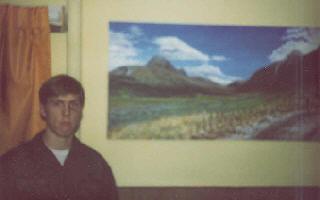
I believe he also ran the "Site Exchange" across the street at A Battery for awhile. The Site Exchange was like a mini-PX where you could buy junk food, pop, beer, smokes, razor blades, and other sundries. One continually popular item was the "Cup'O Noodles" instant noodles that came pre-packaged in the styrofoam cup - you just peeled back the seal and added hot water which was in abundance at the site.
The Site Exchange had a startlingly wide selection of items too, for being such a tiny facility. I bought a compact cassette tape recorder there, and I remember that there was even a tiny B&W TV in stock. This little facility was built into the east wall of the A Battery common area just opposite the mess hall next to the pool tables. When open, a large shutter would swing up out of the way to reveal the counter behind which the person staffing it would exchange your money for the desired items. That place was a Godsend for many of the young privates that were stationed there that had no dependable transportation off site.
Not all of the AADCP people were always at the AADCP. We always had one of our number stationed down on the Aleutian peninsula at the King Salmon NORAD Control Center. This tour usually entailed a six or twelve month stay with the "chosen frozen" Air Force folks down there. I don't know if it was true or not, but I heard it said that in a 100 mile radius around King Salmon there were only about 600 people and 400 of them were Air Force - all pretty much under one roof. I would believe a 60 mile radius. I don't remember what our guy's function down there was, but I do know that he was the only Army person on the whole site. For that reason, whoever got sent down there got a new name from the Air Force folks: "Army". There were few people that ever learned our guy's names, but almost everyone knew "Army". He was the only one that wore green - everyone else there wore blue.
I flew down to visit one of our "Army's" one weekend just to see the place and pay him a visit from a fellow Army guy. The photograph below was taken out the window of the plane as it made its approach to the station.
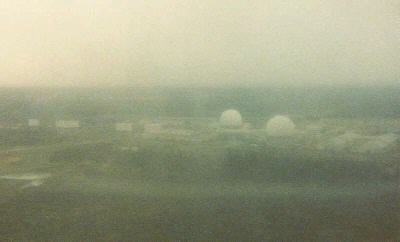
As you can see, it was a very dreary day when I went to King Salmon, but the next day was nice. The station's main building is the large structure to the right of the domes. I beleive the large white structures on the left are a couple of the "White Alice" microwave antennas that connected some of the early warning sites together. The next day I inspected a couple of these antennas and remember that there was nothing living in their path. It was just bare ground leading out in front of those things for hundreds of yards, then you could see some grass and a few little stunted trees in the distance - the result of twenty-seven years in a microwave oven.
An interesting experience happened when my plane landed there. As it turns out, civilian and military traffic share the same runway. Just as soon as we touched down the pilot hit the skids and took us off the runway at what I would consider an excessive rate of speed. Immediately I saw out my window an Air Force jet scrambling past us heading the opposite direction with his wheels already off the ground. I grabbed my camera just in time to catch a blurry image of his wingman who came by just behind him. Welcome to King Salmon. Unfortunately, that is one of the pictures that is missing from my shoe box.
The civilian town of King Salmon was an interesting place at that time. There was a building made mostly of logs that served as the civilian airport terminal, travel agency, outfitters, and a few other functions. There was a larger bluish-grey metal building that served as community center, barber shop, and some other functions that escape me now. There were two bars and one rock&roll band. The band would play at each bar on alternate weeks. The only bar I visited while there was "Eddies", which was actually a very nice place. It is my belief that "Eddie" also owned "Eddies Sandbox" which was the little bar and pool room at the beginning of "battery road" that lead up to site Point where you could usually find a few of the A Battery and AADCP denizens getting some time away from the site.
There was no pavement and only a few houses in King Salmon. Folks that wanted to buy gasoline got it in drums off of a barge that came to the little town of Naknek about 17 miles of dirt road away. I understand that is where the State Trooper lived too. The Air Force station itself was an interesting place. All of the buildings were connected together so you rarely had to go outside to get anywhere in the station, and they had a great burger bar - big succulent hamburgers. It's funny, the things one remembers... One of my best memories of King Salmon Air Force Station was the trophy wall from the "big game hunt".
I suppose it is a mostly forgotten aspect of the Cold War, but at that time Soviet aircraft were continually invading Alaskan airspace, and I suppose we were invading theirs too, but I know nothing of that. In the springtime every year this activity increased pretty dramatically and the Air Force had what they called The Big Game Hunt. I believe the object of the game from the Russian perspective was to probe into Alaskan airspace as far as they could then turn around and escape before the U.S. interceptors got too close. The object of the game from the U.S. perspective was to get close enough to the Russian bombers to get a photograph of the plane's tail numbers. The NATO designations of the Soviet bombers were names like Bear, Bison, Badger, etc. - hence the name "Big Game Hunt". On at least one wall that I remember in the King Salmon Station there were many framed photographs of Russian aircraft. In some of them you could see the faces of the Russian crew members looking out the windows.
One winter there was a feral cat that would come into the Blue Room from time to time through a small opening in the concrete cable trough that came in from the old TTR tower. This cat would pretend to be tame. At times in the middle of the night when things were quiet it would come in and hang around and eventually we earned her trust. Sort of. She would sit on your lap and curl up for a snooze, but without fail, when she was done with her nap she would suddenly jump up, fang you good and hard, then vanish out the door. Weird. Eventually she left and never came back.
There was another cat that graced the AADCP with his presence briefly. Apparently one of the guys had been trapped into promising his girlfriend to find a home for this beast. I'm not sure where it came from, but this was no normal house cat. It looked a lot like one, but he said that it was half Lynx, and I tended to beleive it. The good part was that it was a kitten. The bad part was that it was the size of a large full grown house cat and had a very nasty disposition. He eventually talked one of our 2nd lieutenants into taking it off his hands. The lieutenant was under the impression that it was a full grown house cat. I'm not sure what the lieutenant did with the thing, but he sure had a lot of nasty scabs on his arms for awhile.
After that beast had disappeared for good, one of the guys got a kitten for the barracks. As it turned out this was a real cat that would hang out on the fellow's shoulder most of the time. He named the creature Frederick Theodore Alexander (FTA) and kept him hidden in his living quarters when the 8-5'ers were around, but the cat had pretty free reign at other times. FTA was a good companion to us for a few months up until his owner rotated out.
There is one thing that can be depended on about Army mess halls, and that is that breakfast is always done right. There are no guarantees about the palatability of other meals, but you could always count on a pretty good omelette and a mountain of hash browns at the A Battery Dining Facility. If that wasn't your forte, there was always the old Army standby of SOS and greasy sausages.
Sometimes the A Battery mess hall put out a great spread, and sometimes it was pretty rough. I didn't notice the correlation at the time, but I would be willing to bet that the quality of the food was directly proportional to the readiness state of the Battery. During the weeks of high readiness there were a few more officers required to be on site, so that may have been the key. Not sure.
There are two things I am sure of:
ONE: No one that was there will ever forget "ethnic foods week" or "night" or whatever it was. That didn't go over very well, though it was an interesting experiment and a valiant attempt; and,
TWO: When there was big brass or some other VIP touring the site, we feasted! Steak, lobster, fresh shrimp and salmon, crispy fresh salads... No wonder A Battery's mess hall got that prestigious award for "Best Dining Facility in the Theater" or something. They truly deserved it - sometimes. Other times, well... other times we would send someone into Anchorage for pizza or cook something in our rooms on a hot plate.
But either way you slice it, you've got to hand it to the mess hall crew. They had one of the toughest jobs on that site, providing meals for an entire battery three times a day, seven days a week. Sometimes guys would gripe, but I think everyone with a lick of sense was truly appreciative of their hard work. That goes for the MP's that would get stuck with gate guard duty too. That was a long cold boring job.
No doubt everyone has their own recipes for barracks-expedient nutritional supplements, or midnight snacks. There weren't many places to get a meal at 2:00 in the morning when pulling a watch in the Blue Room. If you had one of those "Cup 'O Noodles" things you were in pretty good shape, but many times you had to exercise a little creativity. Even though the Blue Room was kept frigid for the equipment, there was a steam heat radiator that ran along the east wall. It was normal during a quiet watch to be wrapped in a blanket with your feet up on a chair huddled against that radiator while reading a boring document. On many occasions I would place a raw egg on the top of that radiator and within an hour or so it would be hard boiled in the shell. A slice of bread wrapped in aluminum foil placed there would be toast in about the same amount of time - a simple but effective way to counteract the acid from the coffee you were constantly pumping into your stomach.
We weren't always trapped on site at meal time though. It was common on days off after payday for a bunch of us to pack up and treat ourselves to the fare found in some of the area's restaurants. Here's my favorites:
I wonder if any of these places are still there?
NOTE January 2004: The Hogg Brother's Cafe still exists! (Though in a different location.)
Sometimes the battalion commander or some other wheels would drop by for a visit to the site. They would often arrive in choppers that would land in the field just south of the main buildings. To tour all the sites in a reasonable time would definitely require a helicopter since the batterys were so spread out - especially with C Battery being out in the boonies on the other side of the inlet and B Battery up on the rock. It was not uncommon to be coming up the road from off-site and see a chopper sitting there as you came around the corner toward the gate as in the picture on the left. The picture on the right was taken from outside the south side of the mess hall one spring day.
NOTE January 2004: According to one responder, this area where the choppers landed is now part of a dog training park (Hundenplatz).
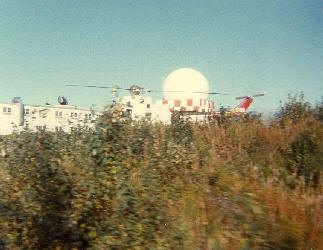
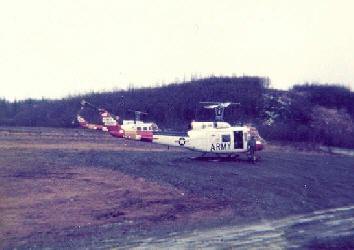
At least once per year site Point would be visited by a VIP of some kind - usually a general of some fame. I only remember two of these visits and only have a photograph of one. The picture on the right was taken in the A Battery common area. In the background is the doorway into the mess hall. The picture on the left is magnified to better reveal the faces.
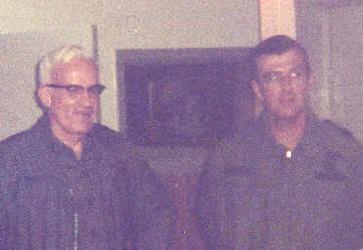

It is my belief that the white haired officer is General Bernard W. Rogers, who was later to be SACEUR (Supreme Allied Commander EURope) under President Ronald Reagan at the end of the Cold War when the Soviet Union folded under the shadow of the U.S.Army's Pershing missiles and the economic might of the West. As I remember he only had three stars at the time of this photo. The officer on the right is probably the commanding general of Fort Richardson, but I just can't remember a name at this time.
One visitor we had is unforgettable though. On Thanksgiving day of 1977 or 1978 the A Battery dining facility had the honor of hosting none other than General James Doolittle and his wife for dinner! He is the guy that, among other famous things (including inventing much of modern avionics), lead the group of modified B-25's that launched from an aircraft carrier, carried out the first bombing raid on the mainland of Japan, then ditched in China in 1942. This heroic and unexpected act demonstrated to the Japanese people that their homeland was not impervious to attack, and gave the American people a tremendous boost in morale after the saddening events at Pearl Harbor and the Phillippines.
General Doolittle and his wife sat at a table on the south side of the mess hall facing the center of the room. The other folks at the table were mostly high ranking folks and I never got a chance to meet him personally, but I did get to eat Thanksgiving dinner in the same room with him. He was quite bald at that time and he and his wife looked genuinely glad to share themselves with the troops. I'll never forget that day. I wish I had a picture of it.
Occasionally some of us would pile into a couple of our cars and head out to see the few parts of Alaska that were accessible by road in those days. We made it above the Arctic circle once before running out of gas money. We saw and stood on the pipeline when it was brand new and visited the NASA tracking station. We were all impressed with the general mood of good cheer in Fairbanks and were awed by the great beauty of the Great Land we were able to experience.

Some of the guys did a lot of fishing trips down the Kenai, though I did most of my fishing via motorcycle up in the Willow and Talkeetna areas (There was a great spot near Talkeetna. Actually, there were great spots everywhere!). We visited Homer and Seward and ate King Crab fresh off the dock, and visited small towns along the way like Ninilchik, pictured below, that had an old Russian Orthodox onion-domed church. I wonder what the place looks like 25 years later?
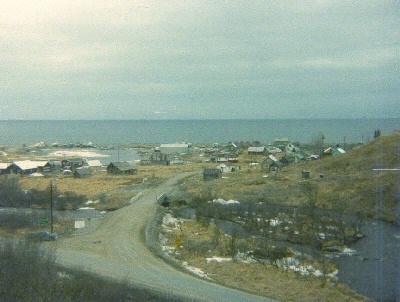
I think it was the winter of 78-79 that there was a wolf problem down on the Kenai. If memory serves, the news had said that there were two large groups of wolves that numbered in the multiple hundreds. The State of Alaska temporarily declared open season on wolves and authorized shooting them from airplanes to try to get a handle on the problem. A few of us decided we would take one day and lend a hand, but circumstances delayed our action and we never got a chance to help. It was kind of eerie driving down there then. The moose were almost lining the highway - lots of them - staying close as if they knew the wolves wouldn't bother them there.
Eventually we spotted two light aircraft circling over something, so we 4-wheeled it a little ways up a road nearby then got out and hiked a bit. We never saw any wolves, but we found where they had dined on a moose or something. The snow was trampled down almost into a hardpack with "dog" prints and the whole area was soaked with blood. There was even blood on the surrounding trees. It was obvious that those "dogs" had thoroughly enjoyed their dinner!
We had some prior warning that the 1/43 was going to be deactivated. On the day that we knew the message to stand down was coming, a lot of us were hanging around the Blue Room waiting for it. Finally, the box crackled and the message came through and was decrypted while we forwarded it to the batterys. When the message was read to the guys hanging around, the beers popped open and there was more than a little foam sloshed around the place. One of the guys had brought his tape player in and we toasted to the tune of Johnny Paycheck's You Can Take This Job and Shove it. We had intended to key the mikes to both the battalion and NORAD tac loops while the tune was playing, but I don't remember if anyone actually ever got up the nerve to do it. I imagine there were guys doing the same thing at all of the batterys. I believe that was 9 April, 1979. That day the 1/43rd stood down and ceased defensive operations and the Anchorage area had no anti-aircraft defense for the first time since World War 2 - for the first time in the state's history, in fact.
As I remember it, that was the beginning of a mass exodus from the battalion. Guys that were hanging around had a lot of slack time and many drifted back to the lower 48 to take some leave time before joining other units. There were a few that were in the same boat I was, with only a few weeks left in our enlistments and so we took terminal leave. I think I left during the first week of July and wasn't around to see much of the deactivation activities, other than tearing some of the equipment out of the Blue Room and helping to load it on trucks. I hear that many of the officers were absorbed by Brigade, for better or for worse.
Someone told me that many in the city of Anchorage were upset about our leaving. Apparently it had been estimated by someone that our battalion infused as much as $49 million into the local economy every year (though that seems a bit too much to beleive). We that served there were looking forward to a change and future opportunities, but I know many of us had fallen in love with The Great Land and were sorry to leave and proud to have served.
I hope this little record of when and where was enjoyable for you. I have purposely left out names and photographs of faces (with two minor exceptions) on the chance that there are some that may not appreciate that. The exercise of going through these old pictures brought many memories. Some good, some bad, and some ugly. I think we all tend to try to remember the glass half full and so I have approached the task of recording this history from that perspective.
A photo of the AADCP building's remaining foundation in 2007:

As to why the IFC buildings at site Point were demolished, one responder suggests that since the buildings were constructed with large amounts of asbestos (which since the time of construction has been deemed a hazardous material) it was determined that "...it would be cheaper and easier to just bulldoze the whole site...". I suppose that would make sense. It appears that the city of Anchorage is preparing to turn the very spot of the IFC into a children's playground.
One of the launcher buildings has been turned into a "chalet" where community events and weddings and such are held. Another one is used for ski waxing and such. In the chalet there is currently a nice display of a Hercules booster fin that was unearthed from one of the old dumps on site.
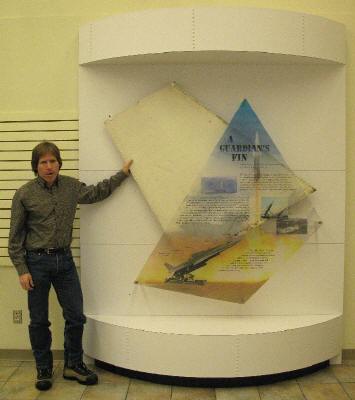

The other launcher section remains fairly intact. This is a view of one of the buildings taken in 2007:
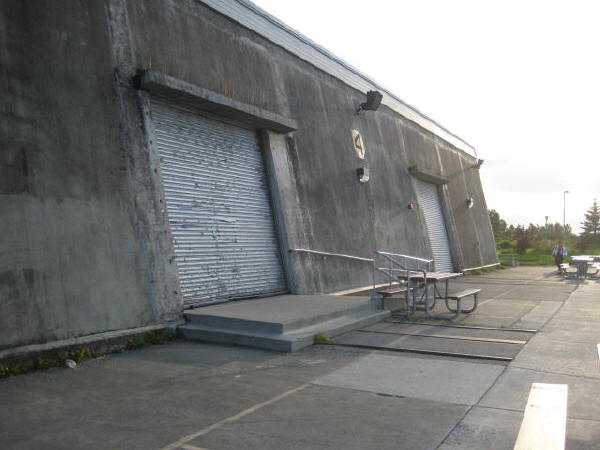
...and a few shots of the interior:
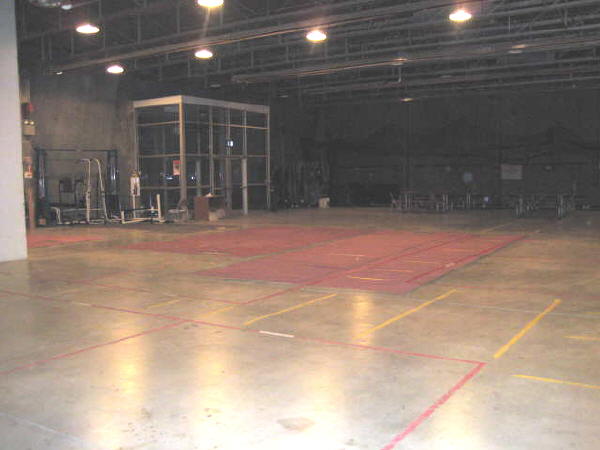
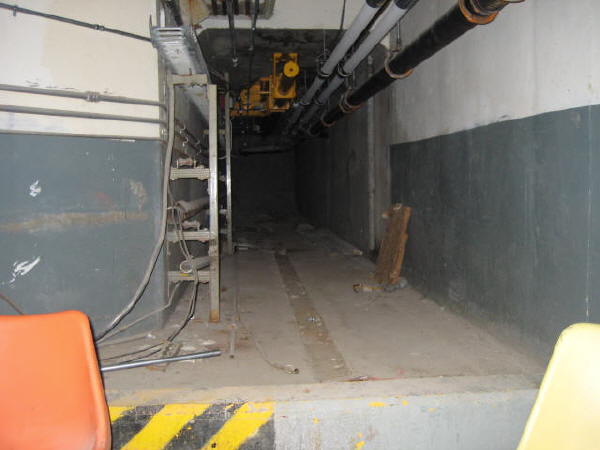


And yes, those funny looking "horses" still graze there.
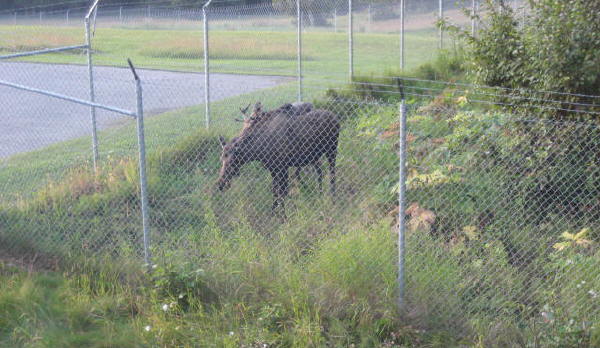
Nike Hercules Operations in Alaska 1959 -1979 a publication produced by the cultural affairs folks at Ft. Richardson in 2004 is now available as a free download from HERE. It comes as 10 separate .pdf files averaging about 1.5 meg each (from about 250K to 3.3 meg) and I'm sure you will find it very interesting and well worth the download time. It contains many anecdotes and items of oral history from many who served at all of the Alaskan Nike sites. Overall I think they did a very good job with it though there are some errors here and there of fairly minor significance.
Cold War Historical Context 1951-1991: Fort Richardson is an interesting 120-some-odd page document (about 6.7 meg .pdf file) that has some great historical perspective and old maps and descriptions of buildings at Ft. Richardson. It is available HERE.
A History of the 4th Missile Battalion (Herc) 43d Artillery This is a very interesting discussion of the histories of the units that became the 43rd ADA presented in the context of world history from 1914, detailing the campaigns that won the unit streamers, the history of the US Army in Alaska, and particularly interesting details about the 120mm AA gun battalion that preceeded the Nike missile units in Alaska. This 9-page single-spaced typewritten document was written by the unit historian circa 1967 and is available for download HERE. Be advised this is a 3.4 meg pdf file and may take several minutes to download through a dialup connection.
The Nike Historical Society
Installing Nike Hercules Missiles in Alaska
Online Air Defense Radar Museum
Ed Thelen's Nike Missile Website
(Ed Thelen's excellent website is one of the most comprehensive collections
of information and links about the Nike program I have seen.)
To view many recent photographs of some Alaskan Nike sites you can click on the following links. These pictures include many of the interiors of some of the buildings and were taken in the summer of 2003 by a couple of guys that like to explore odd abandoned buildings and tunnels and such as a hobby.
Site POINT, Site SUMMIT, Site SUMMIT (more), Site BAY(razed in 2005), Site TARE, Site TARE (more)
- Juliet Tango Sierra, 24 December 2003 The author of this webpage and why he wrote it.

visits since 25 March, 2007